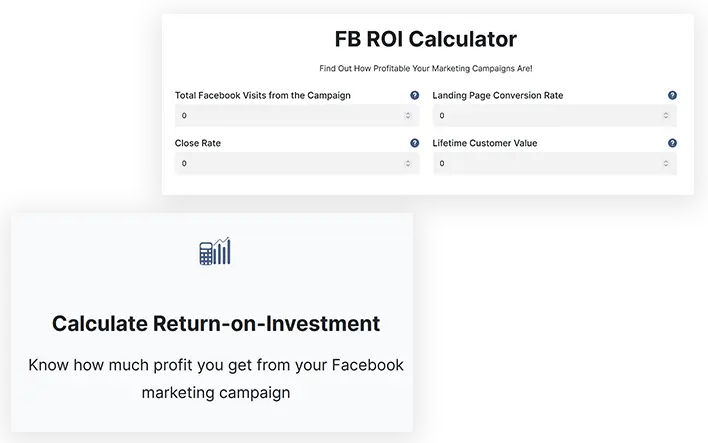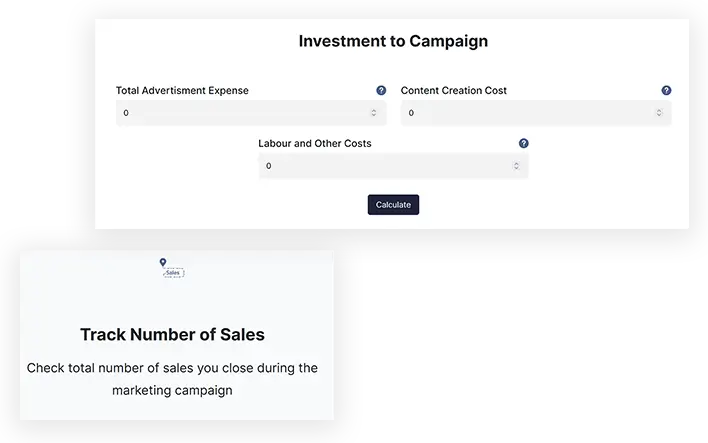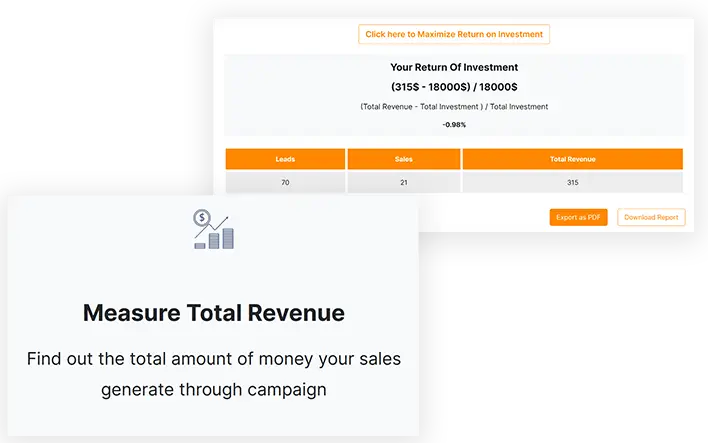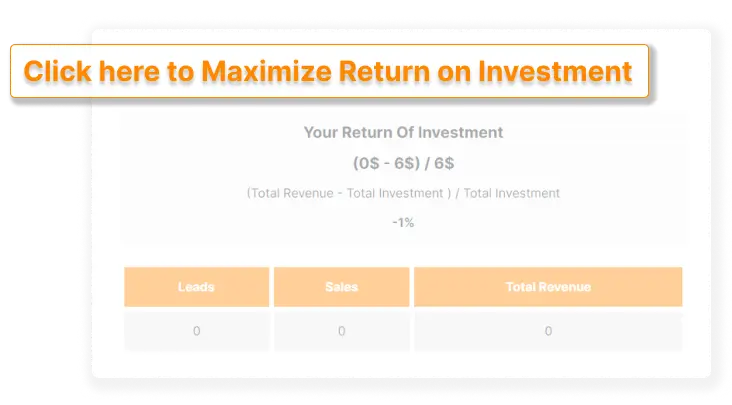Facebook ROI helps to measure the effectiveness and profitability of a marketing campaign. It enables you to estimate how much money you are expected to generate if you run a campaign to sell your products and services via social media.
FB ROI Calculator
Find Out How Profitable Your Marketing Campaigns Are!
Features

Calculate Return-on-Investment
Know how much profit you get from your Facebook marketing campaign

Track Number of Sales
Check total number of sales you close during the marketing campaign

Measure Total Revenue
Find out the total amount of money your sales generate through campaign
Related Tools
ETTVI’s FB ROI Calculator
Gauge the Effectiveness and Profitability of Facebook Marketing Campaigns - For FreeETTVI’s FB ROI Calculator measures the total revenue and profit sellers are expecting to generate through a marketing campaign.
This advanced social media tool marks the success of the FB advertisements and helps to calculate return-on-investment in real-time. Make the best out of this key performance indicator to evaluate the efficiency of the investment and know how much money one can earn from the closed sales.
Just enter the required information about the campaign and see how quickly ETTVI’s FB ROI Calculator measures the total revenue and profit %. To ease off social media marketers, it will highlight the number of total leads and sales as well.
Get an edge over the competitors - measure the degree to which your business is likely to yield profit with the help of ETTVI’s FB ROI Calculator for free of cost.

How to Calculate FB ROI With ETTVI’s Tool?
Let us exemplify how you can calculate Facebook Return-on-Investment with ETTVI’s advanced FB ROI Calculator.
Follow this step-by-step guide based on an example to use ETTVI’s FB ROI Calculator:
STEP 1 - How Much Traffic Your Campaign Drives?
Enter the total number of users who visited your website’s landing page through the Facebook marketing campaign as follows:
You can use the UTM Tags, Google Analytics, or a Time Frame to monitor the FB visits from the campaign.
STEP 2 - How Many Visitors Signed Up on Your Website?
Enter the landing page conversion rate to specify how many visitors engaged with your website’s call to action leads, e.g. email sign up.
Divide the total number of collected emails with the total number of visitors and then multiply the quotient with 100. The product will be your landing page’s conversion rate.
STEP 3 - What is Your Sale’s Closing Ratio?
Enter your sale’s close rate to specify how many deals have been made or track the number of items sold out of the entire merchandise as follows:
STEP 4 - What is Your Lifetime Customer Value?
Enter the lifetime customer value to specify how much revenue your customers are expected to generate throughout their entire life as follows:
To calculate the lifetime customer value, multiply the average number of orders by the average number of annual purchases and the estimated time period during which the potential customers will keep buying from you.
STEP 5 - How Much Money You Invested on Total Advertisement?
Enter the total amount which you have spent to run the campaign as follows:
The total advertisement expense includes the money you pay to the social media managers, content writers, SEOs, and graphic designers for creating and running your campaign.
STEP 6 - What is the Content Creation Cost?
Enter the amount which you have spent on the marketing collateral including written, visual, and aural content for your campaign as follows:
STEP 7 - How Much Does Labor and Other Things Cost?
Enter the hourly wages which you have paid to all the employees. It may range from a few dollars to hundreds or thousand dollars as follows:
STEP 8 - Calculate FB ROI
Click on to run ETTVI’s FB ROI Calculator. Following your command, it will process the given information to calculate your campaign’s return-on-investment and display the results as follows:

Why Use ETTVI’s FB ROI Calculator?
ETTVI’s FB ROI Calculator is an ultimate asset for marketers as it ensures usability, accuracy, and efficiency altogether. Anyone can use this easy-to-use tool to calculate the revenue which is likely to be generated as a result of a marketing campaign - for free of cost.
Have a look below to know what does ETTVI’s FB ROI Calculator offers:
Enhanced User Interface
The user interface of this tool has been designed in such a way that the users can conveniently access and use the functions of this tool. Most importantly, the features of this tool are clearly specified so that the users can easily understand what it does and how it works.
Integrated Manual
Everything the users need to know including what ETTVI’s FB ROI Calculator does and how it works has been clearly stated. In case, the users find it difficult to understand the working of the tool then they can read the step-by-step guide to know how to use it and calculate return-on-investment for free of cost.
Quick Results
ETTVI’s FB ROI Calculator has been designed and developed to efficiently calculate the return-on-investment. For sure, the advanced UI of this tool takes only a few seconds to thoroughly process the given information and display the results with 100% precision and accuracy.
Free Access
ETTVI team knows exactly how to make things unchallenging for the marketers. Therefore, they enables people from all over the world to connect with ETTVI and used the advanced FB ROI Calculator for free of cost. No sign ups or registration fee required!

An Ultimate Guide to Understanding Facebook Return-on-Investment
This helps you focus on the ads with the best chance of bringing in more sales by analysing your Facebook ROI.
How to Calculate Your Facebook Ads' Return on Investment (ROI)
There are two ways you can grow a loyal following on Facebook: advertising and posting updates on your business page. If you want to know how much money you're spending on Facebook advertising, you need to know how many people you've connected with. Cost-per-connection campaigns can be difficult if you frequently update your followers' information. In order to accurately monitor your Facebook activity, you'll need the following information:
- Spend
- Clicks
- Connections
- The cost of a click
As a result, you still need a tracking system that can show you the cost per connection that Facebook gives. Using Facebook data, you could calculate this manually by dividing your spending by the number of connections you have. However, because we prefer to do things more quickly, we use ETTVI's FB ROI Checker to check all of the indicators that are available in the Facebook user interface, as well as that essential cost per-connection statistics. Using this feature, marketers can immediately identify which efforts are cost-effective and which ones require improvement.
The time has come for you to begin promoting your products and services! The contacts you've made will help you generate leads. Using landing pages coupled with your closed-loop analytics software can help you track who becomes a lead as you promote your offerings to your audience. For example, using ETTVI FB ROI Checker, we can see all the leads that were generated by Facebook with the following information:
- Lead source
- Event trigger
- Lead quality
- Date
- Contact information
- Sales details
Why is Facebook Ads Testing Essential?
Advertisers use testing to learn which ads are most effective and then tweak their campaigns to get better results at a lower cost. A lot of the time required, when a marketer claims that Facebook ads aren't working for them, it's because they haven't tested enough or the proper variables.
Too many changes at once or a lack of focus on one particular adjustment can have a negative impact on their results. Both planned and methodical testing of Facebook ads is important.
Making Sense of It
All of your campaign analytics, as well as individual ad results, may be examined in detail.
Campaigns
It's important to make sure that you're comparing campaigns with the same purpose (or "objective," as Facebook refers to it).
An excellent example of this would be a lead-generation campaign utilising a lead-form. However, your second campaign may consist of showing videos to drive traffic to your website, where you can then use retargeting ads to target those visitors who came from your website.
Your campaign's success will be judged by how well it achieves the goal you set.
Sets for Advertising Campaigns
What you should search for here depends on the ad sets you've chosen to test in your campaign. Keep in mind our previous talk on ROI while deciding which ad package performed the best.
Adjusting and determining what to test next, other metrics to keep an eye out for include:
Clicks: The total amount of clicks your ad set has gotten
CTR: click-through rate divided by the number of times your ad was shown to users
Ads
You may see all of the ads that are associated with a specific ad set by clicking on one of those ad sets.
Advertisements' Relevance Scores are something else to keep in mind: On the basis of how successfully your target audience responds, Facebook assigns your ad a score of 1-10. For Facebook to accurately evaluate your score, your ad must have earned enough impressions for the social network to assign you a numerical value for it.
Ads with higher Relevance Scores are more likely to perform well.
Troubleshooting Ad Performance Red Flags on Facebook
When assessing your campaign, ad set, or ad performance, here are several red signs to watch for and ways to resolve them:
If your ads aren't being shown to a large number of individuals, it's probably because your targeting is too specific. You may change the audience targeting for this ad by going to the ad set that it is linked to and making the necessary adjustments. Estimated audience size and reach are available to view.
Another possibility is that your adverts aren't scheduled to run frequently enough. At the ad-set level, you may see the schedule for an ad and add or remove days and hours as needed.
Thirdly, there may be a problem with your ad copy that violates Facebook's rules. This problem is very prevalent, and Facebook may run your ad even though it doesn't appear to as many people as it should.
In the event that none of the above prompts an emotional response, you may need to raise your budget.
Customer Lifetime Value
One of the most important metrics to monitor in a customer experience program is the customer lifetime value (CLV). Client lifetime value (CLV) is a metric for determining how valuable a client is to your organization, not just in terms of individual purchases but over the course of their engagement with your firm.
We all know that sophisticated calculations aren't necessary. Still, you do need to keep in mind the value that a customer gives over the course of their association with your company. You can get a better grasp of CLV's primary drivers by analysing the customer experience and gathering input at all major touchpoints.
Close Rate
A sales professional's or team's close rate or closing ratio is an indicator of how well they're doing. There is a comparison between the number of sales and the number of proposals that have been given. That is to say; it keeps tabs on how many prospects really converted to sales leads.
Is your AD Campaign Generating Enough Views, but no one is clicking on it?
Are your ad copy and creativity appropriate to the people you've set up to be your target audience for your ad? Ad copy and images should be evaluated in numerous ways. A poor click-through rate is usually a sign that you need to re-evaluate who you're trying to reach and re-evaluate your ad's appeal to that group.
Because your advertising isn’t converting, This will all rely on the campaign's goals.
For Instance, if your lead-form advertising isn’t generating leads, that's a major problem. Make sure your advertising is following best practices and test your best-selling products to see if they work.
It's also important to make sure that the landing page you're sending people to is in line with what the advertising promise if your campaign is driving traffic to your site, but they aren't converting as well as expected.
Increase Your Facebook Ads Conversion Rate (CTR)
Facebook Ads has grown from its humble beginnings as Facebook Flyers in 2007 to become one of the most widely used online advertising platforms in the world.
More and more companies are turning to Facebook ads to generate leads, sell items, and enhance their brands, which has driven up the cost per thousand impressions (CPMs).
A greater clickthrough and conversion rate has grown more important as Facebook Ads get more expensive. Due to the escalating cost of advertising on Facebook, ads that performed well in 2010 may not yield a positive ROI today.
There are two approaches to deal with increasing ad prices as a marketer. In the first place, you can try to move your Facebook campaign to another platform and hope that the same or similar pricing will be maintained.
For some reason, this strategy rarely works on Facebook.
The second approach is to improve the clickthrough rate on your Facebook Ads so that you may get more visitors from the same number of ads while paying less for each click (CPC).
In addition to lowering your ad's CPC, boosting your Facebook Ads' CTR has further benefits. You'll get the benefits of a high CTR if your ad is optimised.
Facebook gives you a better Relevance Score, which lowers your advertising expenditures.
Due to a higher level of interaction, your target audience will be more likely to stick around for a longer period of time.
The more people see your ad, the more likely they are to share, like, and comment on it.
There are many ways to go about it when it comes to increasing the number of people who click on your ad.
Optimizing for CTR is far easier than optimising for conversions, which may be a lengthy, data-driven process. With these tips, you'll be increasing your Facebook Ads CTR and driving more traffic at a reduced cost in no time!
Use the Desktop News Feed
A wide range of ad placement options is available on Facebook, including huge News Feed advertising and smaller ads that appear in the right sidebar. Ad sets allow you to select the placements you want to display your advertising.
To get the most out of your ad campaign, you'll want to use News Feed advertisements on Desktop to get the best results. Large images and lengthy descriptions can be used to make this ad type stand out to Facebook users.
Make sure you only select the Desktop News Feed placement for your ad set if you're just getting started with Facebook Ads. Once you've optimised your campaign and established a favourable ROI, you can add additional placements.
You should speak directly to your intended audience.
Which of the two remarks above is more engaging and personal? "You," rather than "people," is more engaging, direct and meaningful to most individuals.
There are two types of ads: those that talk about something and those which talk about something specifically. Imagine yourself doing what the ad depicts, not someone else sitting on a beach or taking in the sights of the French Riviera.
In order for an ad to be effective, it must communicate directly to its target audience.
Make your profile picture stand out from the rest of the content in your News Feed.
News Feed ads are great because they appear above and below people's Facebook updates. On the other hand, sidebar advertisements show in a portion of the page that's devoted solely to advertising and notifications, making them less noticeable.
By choosing generic stock photographs and uninteresting visuals, most advertisers are wasting this opportunity. A simple technique to boost your CTR is to switch from utilizing generic stock images to ones that appear and feel more authentic.

Frequently Ask Questions
Why Should I Calculate the Total Return-on-Investment?
How Does ETTVI’s FB ROI Calculate the Return-on-Investment?
ETTVI’s Advanced FB ROI Calculator requires the Number of Total Facebook Visits from Campaign, Landing Page Conversion Rate, Close Rate, Lifetime Customer Value, Content Creation Cost, and Labour or Other Costs to calculate the return-on-investment in real-time.
How do I Find Landing Page Conversion Rate?
Landing page conversion rate indicates the number of campaign-drived visitors who engaged with a website’s call to action leads, e.g. email sign up. Therefore, to calculate the landing page conversion rate, you can divide the total number of collected emails with the number of users who visited the website from the campaign and then multiply the answer with 100. The end result will be the landing page conversion rate.
How Do I Calculate Close Rate?
Close rate helps to track the number of items which you succeeded to sell during the campaign. Divide the closed deals with the total sales leads and then multiply the quotient with 100 to find the close rate or closing ratio.
How do I Calculate the Content Creation Cost?
The content creation cost includes the amount of money which you have paid to the content writers, graphic designers, and video editors for the creation of your campaign’s marketing collateral.

Stay up to date in the email world.
Subscribe for weekly emails with curated articles, guides, and videos to enhance your tactics.
